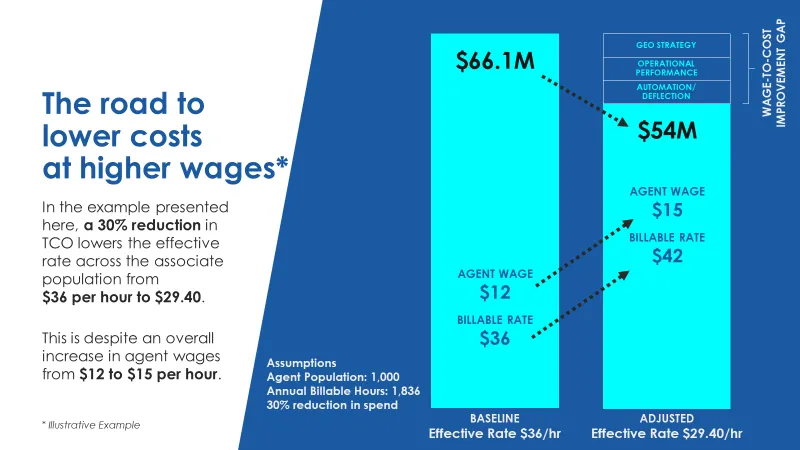How many “help wanted” signs have you seen recently? Nearly everywhere you turn, companies are starving for workers, especially for low-wage jobs. From restaurants and landscaping companies to contact centers and healthcare support, competition is fierce. Potential employees can afford to be choosy, and they want higher wages.
As the economy reopens across the U.S., there is a wave of available jobs without the same supply of available workers. At the same time, the cost of living has risen dramatically, with gas prices, healthcare, childcare, and even food costs continuing to climb. Minimum wage jobs barely get a second look.
According to the Labor Department, there were 9.5 million unfilled jobs as of June 2021, a record high. Job seekers can afford to be selective, thanks to factors like unemployment benefits and remote work options that expand their prospects. The Great Resignation is seeing people voluntarily leave their jobs for better pay, remote work options, less stress, and more.
Meanwhile, the consumer price index rose by 0.9% in June, the largest one-month jump since the 2008 recession, and now sits at 5.4%. Gas prices are up over 56%, used car prices rose 29%, and lumber costs three times what it did last year.
This confluence of inflation, labor shortages and immediate need for workers has resulted in wageflation – a precipitous, unexpected, and immediate rise in wages based on unique market forces. With wageflation, employers pay more for the same job and the same level of productivity.
Even before the pandemic, major brands had committed to raising starting salaries, effectively raising the minimum wage through competition. This trend accelerated substantially as the economy reopened. For example, Amazon, Starbucks, and Target start at $15 per hour, Charter Communications offers $18 per hour, and Bank of America tellers begin at $20 per hour.
Some organizations have turned to lavish incentives like $1,000 signing bonuses, enhanced healthcare and vacation benefits, free mobile phones, free childcare, and other perks previously unheard of for low-wage workers. These moves are to help firms stand out to get candidates through the door.
3 ways to fight wageflation so everyone wins
The contact center industry is especially vulnerable, since most centers operate with high turnover rates and they continuously hire workers to provide customer support and related services. This challenge has gotten even more intense as the need for phone and online contact center staff jumped when stores and other in-person support channels closed and shifted to virtual environments.
So how can contact centers that operate on razor-thin margins increase wages to attract, hire, and retain workers without breaking the bank? The answer is to change how you think about the work. Don’t think of how many employees you need, but instead think of how much work needs to be done. By shifting from an effort to outcome mindset, opportunities emerge to leverage new ways of doing business.
We call it the “effective rate” – a metric that calculates total cost of ownership (TCO) on a per-employee level based on the outcomes produced -- like first-call resolution -- rather than employee effort -- like average handle time.
And in our experience, there are three levers to pull to maintain or increase the effective rate and reduce total cost of ownership with a different mix of employees, enhanced technology, and streamlined processes:
1. Geo strategy: Optimize your geographic footprint by placing jobs in the most cost-efficient locations around the world, based on skill or language required.
Nearshoring and offshoring aren’t new for contact centers, but there are untapped opportunities to incorporate global support in industries or interactions previously off limits. In health insurance, for example, offshore agents can serve as the first step for members or prospective members to field simple questions about information or accounts, and forward more complex questions and sales to a smaller group of licensed U.S. agents.
And even within the U.S., the successful shift to remote work over the past 18 months means that companies are no longer hamstrung by physical locations. Remote workers can be recruited from areas of the country with lower costs of living.
2. Optimize CX delivery: Create an optimal “work location strategy” to get, keep and grow great people with flexible, supportive, employee-first environments with career potential that make them feel valued. Enable work-from-home (WFH), brick-and-mortar facilities, or a hybrid workplace to reduce costs and meet employee needs.
Also encourage and empower employees by streamlining processes and deploying tools to simplify how employees work. Things like a single sign-on to all systems or an AI-enabled knowledgebase helps to make each customer-facing tasks more efficient while boosting employee satisfaction.
3. Automation & deflection: Self-service, digital channels, call deflection, and
automation reduce costs and employee effort, improving productivity and efficiency without skimping on service. Fewer people can leverage technology to do as much or more work.
In many cases, automation and deflection technologies like chatbots, automated IVR, and SMS messaging vastly improve the effectiveness of customer interactions with fewer employees and more satisfied customers. For example, one contact center associate can handle up to four concurrent SMS text messages compared to one phone call.
These three levers drive contact center deflection, efficiency and performance, lowering the total cost of ownership. They bring down the effective rate across the employee population even as wages increase to meet market demand.

The image above provides an illustrative example. Let’s say you have 1,000 customer service associates who make $12 per hour and your contact center costs are $66 million. The effective rate is $36 per agent. Deploying the three levers above, you move some simple calls offshore, deflect password reset calls with automated customer self-service, and add SMS messaging options for customers. Now, customer support agents are more productive and can serve more customers. Even with a wage increase from $12 to $15 per hour, contact center costs drop to $54 million. This represents a 30% reduction in TCO, which lowers the effective rate across the employee population from $36 per hour to $29.40 per agent.
This model shows that contact centers can be as or more productive with a different employee landscape than with their current (potentially underpaid) workforce, freeing up budget to increase wages. When employees’ needs are met and they feel valued, their happiness will translate to happy customers without sacrificing the bottom line.
So while wageflation may have a negative connotation, it could also lead to a better way to do business for your business, your employees, and your customers.















